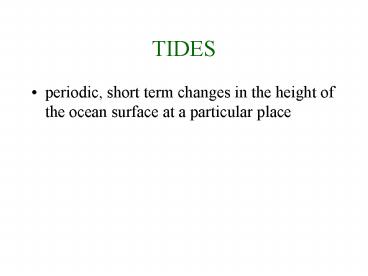TIDES PowerPoint PPT Presentation
1 / 39
Title: TIDES
1
TIDES
- periodic, short term changes in the height of the
ocean surface at a particular place
2
(No Transcript)
3
What causes tides?
- a combination of the gravitational force of the
moon and sun and the rotation of the earth - moon exerts greater effect than the sun
4
Tides are waves
- Tides are simply specific types of waves, we
now know that waves can be either deep or shallow
and long or short - Thus, tides are the longest of all (shallow
water) wave examples - longest and largest of all waves in the ocean
tideswavelengths of half the Earths
circumference (max.) - High tide is the crest of the wave and low tide
is the trough
5
Studies
- 2 scientists (combined) explain the effects and
daily occurrence of tides - Newton
- Laplace
6
Equilibrium Theory of Tides
- Isaac Newton, 1600s
- Would accurately describe tides on a planet
uniformly covered with water through a
gravitational model - Does not consider the effects of continents,
ocean basin shape and ocean depth - Explains the effects of the gravitational
attractions of Earth, moon and sun (with the
influence of the moon being 50 greater than that
of the sun)
7
Newton Equilibrium theory
- Planets orbit the sun in balance between gravity
and inertia - Not moving, gravity pulls planet to sun (b) if
planet - is moving inertia will maintain straight line
(c) together - you get a fixed path for planet orbit.
Fig 10-2, p.229
8
Newton/Equilibrium theory
- Assumes the ocean conforms instantly to the
forces that affect the position of its surface
i.e. the oceans surface is always in equilibrium
(balance) with the forces acting on it.
9
Whats missing?
- There are continents in the way of the water
moving! - The ocean basin is not flat and/or uniform!
- Average tidal range 7 for world (thus NOT at
equilibrium)!
10
Dynamic Theory of tides
- Laplace, 1775 (1 century later)
- A modification to Newtons gravitational model
the Dynamic Theory - Now considers ocean depth, continents, the shape
of the basin AND what that means to
long-wavelength tides/waves in shallow waters
11
Tides in basins, confined areas etc.
12
Different tides in different locations!
13
Put both theories together
- Newton explains HOW the tides occur
- Laplace explains how they INTERACT with the
surrounding environment (continental margins and
shores and even ocean basin depth) - Result What we now know as daily tides
14
Moon doesnt rotate around the center of earth
but instead around its center of mass
(illustrated) they, in turn, together rotate
around this center point. (complete cycle every
27.3 days)
15
Moons gravity attracts the ocean toward it,
tidal bulge on opposite side(s).
16
How tides occur...
- The bulges stayes aligned with the moon as the
earth rotates on its axis, - as points on the earth pass through the bulges,
they experience high tide
17
Bulges follow the moon
18
Fig 10-7, p.231
19
Fig. 10-8, p. 232
20
Other factors affecting tides...
- 1 - the moon rises 50 min. later each day
- Thus high tides occur about 50 min later each
day. - Remember (in the NE) there are 2 high and 2 low
tides per tidal cycle (roughly 6 hrs. apart)
21
Fnft
22
Other factors affecting tides...
- 2 - the moon moves each month from a position
28.5o above to 28.5o below the equator - leads to unequal tides a high high and a lower
high that same day.
23
Tides can be even higher and lower All based on
moons position.
24
Tidal regimes
- Semidiurnal tides two high tides and two low
tides of nearly equal level each lunar day - Diurnal tides one high and one low tide each
lunar day - Mixed tides when successive high or low tides
are significantly different in height
25
(No Transcript)
26
(No Transcript)
27
Influence of the Sun
- The effects of the sun and moon cause wave
interference - constructive interferencehigher high tides and
lower low tides spring tides - destructive interferencelower high tides and
higher low tides neap tides
28
Fig 10-11, p.233
29
fnft
30
Highest high tides spring tides
31
Interesting additions to tides
- Tidal range is different/unique in each location
depending upon the topograpgy of the ocean basin
underneath the water AND the continental
margin(s) shape. - Tidal range high-water to low-water height
differences in an area
32
A narrow basin
B Bay of Fundy
Tides in basins, confined areas etc.
33
(No Transcript)
34
(No Transcript)
35
France, 46, Fig. 10-1a, p. 229
36
Fig. 10-1b, p. 229
37
Effects? Tidal currents
- Rise and fall in sea-level as the tidal crest
passes will cause currents - Water rushing toward shore due to rising
sea-level is called a flood current - Water rushing away from shore is called an ebb
current - Slack water a time of no current occurs at high
or low tide
38
(No Transcript)
39
And finally tides effect marine life!
- Tides produce severe zonation
- Currents move fish/planktonic organisms to
extreme locations (even more severe during
storms) - Seasons effect temperature and that effects
everything! - Ex. Grunion swim up on shore to deposit eggs
during an extreme spring tide each year

